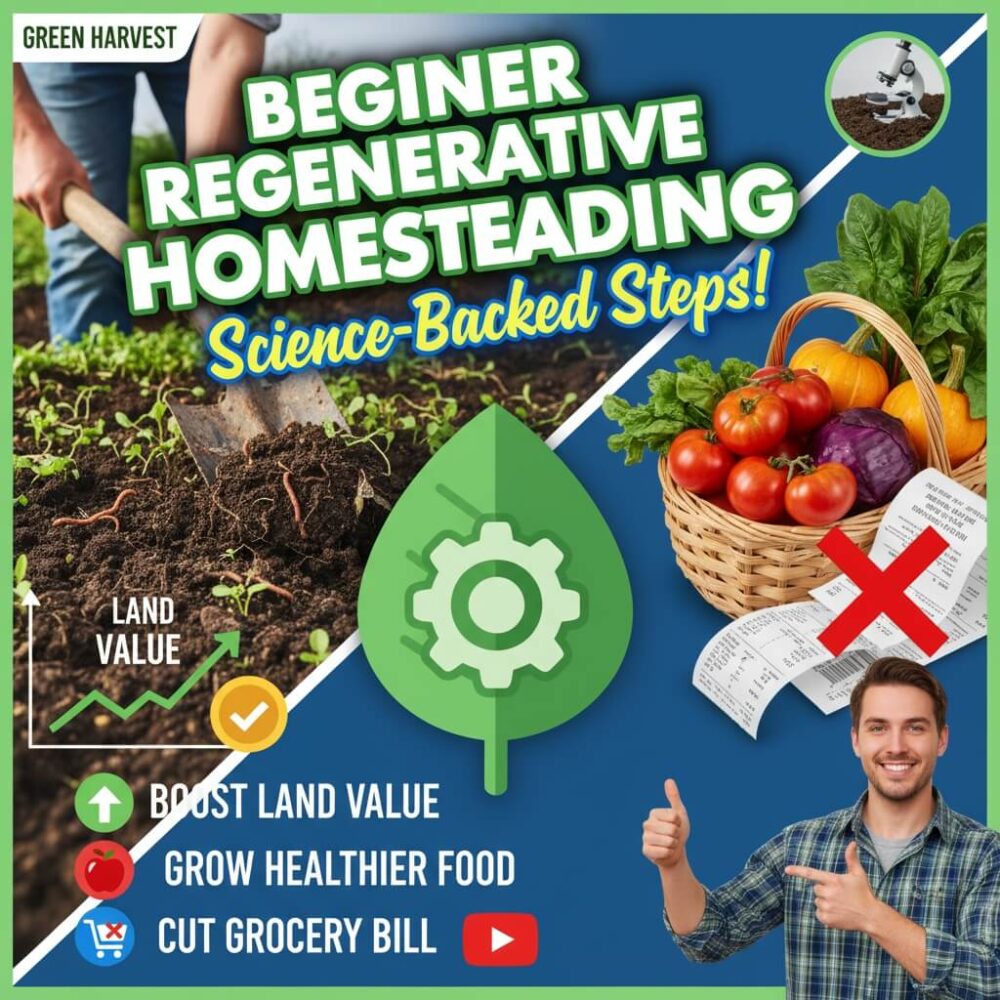There’s a moment when it clicks—when you realize the way you’ve been taught to grow food, manage land, and feed your family might not align with what actually works.
Maybe it’s when your garden soil turns to concrete after rain, or you’re spending hundreds each month on grocery produce that tastes like nothing. That’s when regenerative homesteading stops being a buzzword and becomes a real path forward.
The difference between conventional homesteading and regenerative practices isn’t subtle. It’s the difference between extracting from your land and partnering with it.
And the evidence keeps mounting: this partnership pays dividends—in your soil, your harvest, your wallet, and the long-term health of what you’re building.
Table of Contents
Why Regenerative Practices Outperform Conventional Homesteading
The Evidence: Enhanced Soil, Fewer Chemicals, Real Results

Walk barefoot through two gardens—one managed conventionally, the other regeneratively—and you’ll know the story before your eyes do. Regenerative soil feels alive, crumbling in your fingers instead of forming rock-hard clods. That’s not poetry; it’s biology in action.
Stopping tillage and starting soil-building initiates something extraordinary below the surface. NIH research shows regenerative agriculture creates soil microbial diversity that’s measurably richer than conventional approaches.
The bacterial communities in regenerative plots demonstrate significantly higher diversity, with beneficial microbes like Pseudomonas species—known plant-growth promoters—appearing at much higher concentrations than conventional systems (see full study).
These microbes are the foundation. They fix nitrogen, suppress disease, improve water retention, and make nutrients available in forms your plants can use. When you work with these microscopic partners, your plants become more resilient, pest pressure drops, and you stop needing chemicals because your soil does the work.
Long-term research confirms continued increases in bacterial diversity with extended application of regenerative techniques (Frontiers in Agronomy). Stronger plants, better yields, and fewer external inputs—it’s all backed by data.
Economic Advantages: Lower Inputs, Higher Long-Term Value
Here’s the impact on your bank account: regenerative systems cost less to run and increase in value over time.
Eliminating synthetic fertilizers and pesticides, plus natural pest management, cuts costs dramatically. Land managed regeneratively is now recognized by appraisers as more valuable because it produces consistent yields, demands lower input costs, and carries less liability (Mother Earth News: Boost Land Value).
Family farms making the shift report sustained cost reductions as soil health improves year-over-year—keeping money in your pocket rather than flowing to chemical suppliers.
10 High-Impact Regenerative Practices to Start Immediately

Companion Planting for Pest and Disease Control
Companion planting mirrors what happens in nature. Plant tomatoes with basil and the basil repels tomato pests. No need for spraying—your plants have each other’s backs.
Research confirms what gardeners intuitively know: marigolds intercropped with kale drastically reduce aphid populations by attracting predatory insects (Epic Gardening: Companion Planting Science). Nasturtiums trap pests away from your vegetables, and legumes fix nitrogen right into the roots of neighboring plants.
Poly-planting actually confuses pests, disrupting their ability to target crops (Beginner’s Garden – Pest Control).
Cover Cropping for Erosion and Fertility
Cover crops are insurance. Rye, clover, or alfalfa blanket bare earth, preventing erosion and cycling nutrients back for your next harvest (NIH: Nitrogen Leaching and Cover Crops).
Legumes form partnerships with bacteria to extract nitrogen from the air and lock it in root nodules. When you turn under the crop, that nitrogen becomes available for the next planting. Purdue University confirms non-legume covers scavenge residual soil nitrate, recycling it efficiently.
Rotational Grazing for Faster Recovery
Even small livestock can improve land health with rotational grazing. Instead of constant grazing, rotate animals intensively through one area and let it rest. Soil absorbs more nutrients, roots deepen, and pastures rebound stronger.
For details on implementation, check out Cargill’s guide to rotational grazing or Mary’s Land Farm’s real-world results.
Natural Beekeeping for Pollination and Honey
Pollination is critical. If bees aren’t visiting, your yields tumble. Low-intervention, natural hives bring committed pollinators to your plot. NIH and Royal Society Open Science detail how bee pollination lifts fruit weight, shelf life, and commercial grades.
For a hands-on tutorial, explore channels such as BeeKeepingCoach on YouTube.
Agroforestry for Shade, Food, and Habitat
Interplanting trees with crops harnesses nature’s layering. Nitrogen-fixing trees provide shade, food, and habitat, while deep roots enhance microclimates and soil moisture. Productivity per unit area often outpaces monoculture—see this comprehensive study.
Hugelkultur and Swales: Water and Biointensive Beds
Hugelkultur is simple: bury wood, pile soil. The wood acts as a sponge, feeding water back to roots and fungi. In dry climates, it conserves irrigation; in wet climates, elevates plants above soggy soils. Permaculture Magazine and Hugelkultur Australia show the water and cost benefits.
Watch The TRUTH About Hugelkultur And Filling Raised Beds With Logs on YouTube for a step-by-step look.
Swales capture runoff, recharge groundwater, and fortify plant growth during drought.
Vermicomposting: Turning Waste Into Profit
Kitchen scraps morph into high-grade compost in a worm bin. Vermicompost is loaded: 5x nitrogen, 7x potash, and 1.5x calcium compared to soil (NIH). Tomato yields can jump over 74%—plus faster germination and earlier flowering.
For yield details, visit USDA NARC’s vermicompost trial.
DIY Soil Testing and Amendments
You can’t manage what you don’t measure. Purdue’s cover crop guide covers simple soil tests. Test pH, organic matter, and nutrients. Amend based on results, not guesses, for targeted improvements.
I recommend midwestlabs soil tests
Edible Perennials: The Effortless Food Supply
Perennials—like asparagus, berry bushes, fruit trees—give for years from one planting. UMN Extension’s asparagus guide covers everything you need to start for decades of harvest.
Case Studies and Proof—Real Families, Real Results
Small Plot, Big Impact: Earning with Less Land

Families with just a tenth of an acre, intensively companion planted and cover cropped, have doubled the productivity and profits of conventional setups on the same land. Mother Earth News shares multiple stories.
The Grocery Bill Experiment: Year-One Savings Breakdown
One family eating mostly from their regenerative homestead reduced monthly grocery spending from $1,100 to $525—saving $6,900 after expenses in a year. Quality of food improved, and health gains followed within months.
Calculating the Savings in Growing Your Own Food
Essential Tools and Resource List—What You Actually Need
Compost bin or worm tower: Worm composting basics.
Basic soil test kit: How to test your soil.
Mulch materials: Check for local recycling centers.
Hand tools: Broadfork, hoe, pruners—look for regional suppliers.
Seeds: Find a seed bank near you.
Total first-year investment: $150–$330 for a productive, regenerative-ready plot. Compare that to your first-year grocery savings.
Local agricultural extension offices: Search “[Your County] Cooperative Extension” for guidance, free consults, and discounted soil tests.
Online communities: Regenerative Organic Alliance, Permaculture forums.
YouTube: For visual tutorials, start with
Overcoming Roadblocks and Staying Motivated
Weather, Wildlife, and Unexpected Setbacks
Failures are part of the journey—rabbits, frost, rains. Design with redundancy, plant diverse varieties, install predator fencing, and learn each season.
Community Support: Where to Turn When Stuck
Isolation kills motivation. Connect through local permaculture guilds, meetups, seed swaps, and online forums. Immediate wisdom and encouragement await in groups like Permaculture forums or Regenerative Organic Alliance.
FAQ: Questions Beginners Actually Ask
What’s the fastest way to boost my soil?
Cover cropping in autumn and composting year-round delivers rapid improvements. Cover crop research
Can I do regenerative homesteading on a small plot?
Yes—micro methods work in containers and tiny yards. Companion Planting Science
How long until soil truly restores?
Measurable gains show up within 1-2 seasons. Deep restoration builds in 3–7 years, depending on your starting point. Soil Health Research
What mistakes kill most beginners?
Doing everything at once, over-amending, skipping soil tests. Start small, build soil, then expand.
How do I measure success?
Test soil, track your grocery bills, document your time and results with before-and-after photos.
Products, Tools & Resources

Soil Test Kits:
Purdue Guide | Find a local Extension Office
Vermicompost Bins:
USDA NARC Trial
Cover Crop Seeds:
UMN Extension
Broadfork Tool, Hand Tools, Mulch:
Check local nurseries or permaculture swap groups.
Perennial Plants:
UMN Extension Asparagus
Online Communities and YouTube:
Regenerative Organic Alliance
Permaculture Forums
The TRUTH About Hugelkultur And Filling Raised Beds With Logs
Transitioning to regenerative homesteading is a journey, not a leap. Each season teaches something valuable—that patch of soil, that bee hive, that new perennial bed, each brings you closer to land that is alive and abundant.



